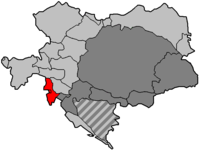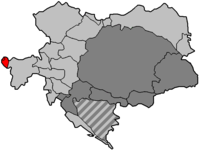Flags of Austria-Hungary

During its existence,
k.u.k.
War Fleet continued to carry the Austrian ensign it had used since 1786 and the regiments of the k.u.k. Army carried the double-eagle banners they had used before 1867, as they had a long history in many cases. New ensigns created in 1915 were not implemented due to the ongoing war. At state functions, the Austrian black-yellow and the Hungarian red-white-green tricolor were used.
Austria was represented by the black-yellow flag. The Hungarian half of the state, on the other hand, legally had no flag of its own.embassies flew the two national flags alongside the imperial standard.[4]
National and state flags
-
Habsburg Monarchy (including Austrian and Austro-Hungarian Empire), also used to represent Cisleithania
-
Flag of theTransleithania
-
Flag of the Kingdom of Hungary (coat of arms variant without supporters)
-
Flag of the Kingdom of Hungary (civil flag)
-
Flag of the Kingdom of Croatia-Slavonia
-
Unofficial,[a] but common flag of the Kingdom of Croatia-Slavonia
-
Flag of the Kingdom of Croatia-Slavonia (civil flag)
Imperial and military standards
-
Emperor's imperial standard (until 1915)[5]
-
Empress's imperial standard (until 1915)[5]
-
Emperor's and Empress's imperial standard
(1915–1918)[5] -
Archduke's and Archduchess's standard (1915-1918)
Ensigns
Civil ensigns
-
Civil ensign 1786–1869[7]
-
Civil ensign 1869–1918,better source needed]
-
Unofficial Hungarian civil ensign used on Transleithania inland waters[7]
-
Naval ensign 1915–1918
(not implemented)[10]
Regional flags
Additionally, several flags were in use within the local territories of Austria-Hungary.
| Location | Region name | Flag | |||
|---|---|---|---|---|---|

|
Archduchy of Austria (Lower Austria) |

| |||

|
Archduchy of Austria (Upper Austria) |

| |||

|
Kingdom of Bohemia | 
| |||

|
Kingdom of Dalmatia | 
| |||

|
Kingdom of Galicia and Lodomeria |  (1849–1890)  (1890–1918) | |||

|
County of Tyrol | 
| |||

|
Duchy of Bukovina | 
| |||

|
Duchy of Upper and Lower Silesia
|

| |||

|
Duchy of Carinthia | 
| |||

|
Duchy of Carniola | 
| |||

|
Duchy of Salzburg | 
| |||

|
Duchy of Styria | 
| |||

|
Margraviate of Moravia | 
| |||

|
Austrian Littoral, including:
Princely County of Gorizia and Gradisca |
 (Austrian Littoral)
| |||

|
Vorarlberg | 
| |||
| Location | Region name | Flag | |||

|
Kingdom of Hungary | 
| |||

|
Principality of Transylvania | 
| |||

|
Voivodeship of Serbia and Banat of Temeschwar | 
| |||

|
Kingdom of Croatia-Slavonia | 
| |||

|
Kingdom of Croatia | 
| |||

|
Kingdom of Slavonia | 
| |||

|
City of Fiume and its District
|

| |||
| Location | Region name | Flag | |||

|
Condominium of Bosnia and Herzegovina
|

| |||
Examples of using flags in the era
-
Visit of Emperor Franz Joseph I in Zagreb, red-white-blue (Croatian) flags, 1895
-
Civil ensign and Austrian pennants on a French illustration advertising the Hungarian pavilion during Exposition Universelle in Paris, 1900
-
EmperorFranz Joseph I in Merano(black-yellow flag), 1900
-
Bohinj tunnel opening ceremony (two-color flags), 1906
-
Military base of Austro-Hungarian Army (two-color flag), 1910
-
SS Carniola - Austro-Hungarian civilian steamship with civil ensign, 1912
-
Military parade in Vienna (two-color flags), 1913
-
Imperial Standard on the car of Archduke Franz Ferdinand, 1914
-
Soldiers of Infanterieregiment Nr. 17 with two-color flag, 1914
-
Austro-Hungarian propaganda poster encouraging to buy war bonds
-
World War I-era propaganda postcards depicting the flags of the Central Powers. The Austro-Hungarian flag shown as black-yellow
-
A propaganda postcard commemorating the release of the Przemyśl fortress. Austria-Hungary represented by the black-yellow and red-white-green flags, 1915
-
Another Central Powers propaganda, with Austria-Hungary being represented by a mix of both Habsburg and Hungarian flags
-
Copy of the naval ensign taken by the Italian army from the submarine U12 at the Piave river mouths on 5 August 1915 (exposed in Museo Storico Navale, Venice).
-
Emperor Charles I visiting Pergine (two- and three-color flags), 1917
-
Vienna Praterstrasse, 1917
-
Emperor Charles I visiting troops in Ozhydiv (two- and three-color flags), 1917
-
Emperor Charles I in front of the Hungarian flag, 1917
-
Emperor Charles I visiting one of the villages in South Tyrol (two-color flag), 1917
-
SMS Gäa - Austro-Hungarian torpedo carrier with naval ensign, World War I period
Wikimedia Commons has media related to Austro-Hungarian flags in art.
Wikimedia Commons has media related to Austro-Hungarian flags on photographs.
See also
References
- ^ The official version prescribed the Crown of St. Stephen, the same as on the Hungarian flag, to be used. See Kingdom of Croatia-Slavonia: Symbols
- ^ a b "Habsburg | H-Net". www.h-net.org. Archived from the original on 10 February 2012.
- ^ Austria. Reichsrat. Abgeordnetenhaus (1903). Stenographische protokolle über die sitzungen ...: 1. (eröffnungs-) bis [485.] sitzung ... Aus der K.-k. Hof -und staatsdruckerei. p. 20714.:
Der § 63 spricht auch von einer kroatisch-slavonisch-dalmatinischen vereinigten Fahne auf Reichstagsgebäude. Diese Fahne war bis anno domini 1902 allen Dimensionen nach gleich ungarische Fahne.
- ^ a b Pliverić, Josip (1907). Spomenica o državnopravnih pitanjih hrvatsko-ugarskih. Zagreb: Hartman (Stjepan Kugli)., p. 50
- ^ Rudolf Agstner, Austria(-Hungary) and Its Consulates in the United States of America since 1820 (LIT Verlag, 2012), p. 45.
- ^ a b c "Imperial Standard of Austria, Flags of the World".
- ^ "Austro-Hungarian Empire: Military Flags".
- ^ a b c The Flags & Arms of the Modern Era
- ^ Album of standards, flags and pennants of the Russian Empire and foreign states. 1890. p. 39.
- ^ When Wikipedia has the Flag Wrong. Retrieved 2024-04-01 – via www.youtube.com.
- ^ The Flags & Arms of the Modern Era






![Unofficial,[a] but common flag of the Kingdom of Croatia-Slavonia](http://upload.wikimedia.org/wikipedia/commons/thumb/6/62/Flag_of_the_Triune_Kingdom_of_Croatia%2C_Slavonia_and_Dalmatia.svg/120px-Flag_of_the_Triune_Kingdom_of_Croatia%2C_Slavonia_and_Dalmatia.svg.png)

![Emperor's imperial standard (until 1915)[5]](http://upload.wikimedia.org/wikipedia/commons/thumb/6/64/Imperial_Standard_of_Austria-Hungary_%28Before_1915%29.svg/120px-Imperial_Standard_of_Austria-Hungary_%28Before_1915%29.svg.png)
![Empress's imperial standard (until 1915)[5]](http://upload.wikimedia.org/wikipedia/commons/thumb/e/e3/Austro-Hungarian_Empress_Standard_%28Before_1915%29.svg/120px-Austro-Hungarian_Empress_Standard_%28Before_1915%29.svg.png)
![Emperor's and Empress's imperial standard (1915–1918)[5]](http://upload.wikimedia.org/wikipedia/commons/thumb/f/f5/Imperial_Standard_of_the_Emperor_of_Austria_%281915%E2%80%931918%29.svg/120px-Imperial_Standard_of_the_Emperor_of_Austria_%281915%E2%80%931918%29.svg.png)

![Military standard (example of many variants)[6]](http://upload.wikimedia.org/wikipedia/commons/thumb/9/9a/Austrian_Imperial_Standard_-_Infantry_pattern_mix_early_19th_century.svg/120px-Austrian_Imperial_Standard_-_Infantry_pattern_mix_early_19th_century.svg.png)
![Civil ensign 1786–1869[7]](http://upload.wikimedia.org/wikipedia/commons/thumb/7/72/Austria-Hungary-flag-1869-1914-naval-1786-1869-merchant.svg/120px-Austria-Hungary-flag-1869-1914-naval-1786-1869-merchant.svg.png)
![Civil ensign 1869–1918,[8] erroneously seen as the "national flag" of Austria-Hungary in popular culture.[9][better source needed]](http://upload.wikimedia.org/wikipedia/commons/thumb/e/e8/Ensign_of_Austro-Hungarian_civil_fleet_%281869-1918%29.svg/120px-Ensign_of_Austro-Hungarian_civil_fleet_%281869-1918%29.svg.png)

![Naval ensign 1786–1915 (de facto until 1918)[7]](http://upload.wikimedia.org/wikipedia/commons/thumb/a/aa/Naval_Ensign_of_Austria-Hungary_%281894%E2%80%931915%29.svg/120px-Naval_Ensign_of_Austria-Hungary_%281894%E2%80%931915%29.svg.png)
![Naval ensign 1915–1918 (not implemented)[10]](http://upload.wikimedia.org/wikipedia/commons/thumb/f/f3/Naval_Ensign_of_Austria-Hungary_%281915%29.svg/120px-Naval_Ensign_of_Austria-Hungary_%281915%29.svg.png)





















